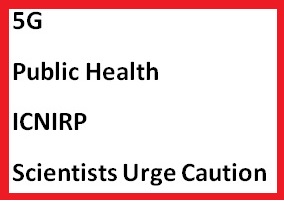What ICNIRP is saying:
 Eric Van Rongen, ICNIRP Chair
Eric Van Rongen, ICNIRP Chair
Eric Van Rongen:
“ICNIRP establishes whether health effects have been found and, on the basis of that, sets its limits. That is done with a large degree of conservatism. While many 5G pilots are already under way, ICNIRP is reviewing its own mobile technology-related radiation advice and is expected to release revised limits later this year. ICNIRP is in the process of updating mobile phone radiation limit values – new guidelines are expected in 2019.
ICNIRP evaluates the scientific literature. On the basis of that, it establishes the effects of exposure to EMF. Those established effects serve as the basis for the exposure limits that ICNIRP sets.
We discussed the 120 submissions and more than 1,000 individual comments received during the public consultation of our draft guidelines for exposure to radio-frequency electromagnetic fields. At the same time, the WHO is working on an extensive review of all the literature on the exposure of EMF. We can use the information of that review.”
When asked whether ICNIRP is convinced that there are no non-thermal effects from 5G radiation, Van Rongen concedes: “No, we’re not convinced of that. We know there are non-thermal effects. But we’re not convinced that these have been established as adverse health effects.”
Source:
https://www.computerweekly.com/feature/Mobile-phones-and-health-is-5G-being-rolled-out-too-fast

Martin Röösli ICNIRP Member
Röösli on 5G: “We can rest assured”
Source:
Martin Röösli is professor of environmental epidemiology at the University of Basel. He is head of the Environmental Exposure and Health Unit at the Tropical Institute and Public Health in Basel and directs the Berenis group (the Group of experts on non-ionizing radiation. He has been a member of ICNIRP since 2016.
-We can exclude that the 5G antennas cause risks for long-term health?
Professor Martin Röösli: “Science can never say ‘ never’. Science can, with ample security, exclude that there are consequences for health. However, it is important to observe and continue to search where it is they show uncertainties, for example if for a long time a sector is strongly exposed. Given the current knowledge, it is unlikely that any news will emerge on the health effects. But of course, it must be taken into account that science cannot prove that something is impossible in absolute. When science discovers something, it is at that moment that it can say: ‘Now we know.’ But if we don’t find … then we don’t know.”
-In your opinion it is necessary to be more cautious with the introduction of 5G?
Professor. Martin Röösli: “We are already doing several studies and, if there were a great risk , it would have already emerged. It is in the nature of things that there are uncertainties. Currently the safety factor is good. But it is also important that we continue to observe, not to miss anything. I don’t think it’s very dangerous to introduce 5G.”
-Millimeter waves – a danger?
Professor. Martin Röösli: ‘There are still only a few studies in this regard. There are already studies on cells, where effects have been observed. At the moment this does not suggest that they could cause different health effects. But before really introducing millimeter waves, I think it is important to do further studies and observe with even greater precision. ”
-The 5G modulation is different. Could this have any health effects?
Professor. Martin Röösli: “The important thing to know is that we are now at the fifth generation of mobile telephony and that for each generation there are different modulations. Each signal is different, there is not one certain modulation. So far it has never been discovered that it would be important if the signal were modulated in this way rather than in another. The worst, from the point of view of health, was 2G, which had strong peaks. From this point on in reality, 4G, 5G, have fewer peaks. In general, I do not think it is think it is very relevant how exactly it is modulated. ”
Scientists argue for more research:

The Swiss Foundation for Research on Information Technologies in Society (IT’IS) is an independent, non-profit organisation that researches the safety and quality of emerging electromagnetic technologies.
The foundation’s director and co-founder, Niels Kuster, says the implementation of 5G will use much higher frequency bands than 2G, 3G or 4G to satisfy the growing demand in data rates, but this induces much higher power density in human skin.
His colleague, Esra Neufeld, a scientist and consultant, adds: “The current standards do not prevent thermal damage of the skin and should be corrected in the next revision of the guidelines.”
5G will operate in a range of frequencies known as the millimetre wave band. Neufeld says there are “almost no studies at the millimetre wave range which can be used [to assess] risks that technology poses for people, and such research is urgently needed.”
One of the most renowned experts on environment policy in Germany, professor Ernst von Weizsäcker, goes further, calling for the deployment of 5G to be delayed until its risks are understood:
“We do not know for sure whether the mobile data transmission technology poses health risks, but we cannot yet exclude it either. Thus, we must insist that the health risks associated with the omnipresent radio-frequency radiation for mobile devices are studied before we expose the whole population with ever-rising levels of the electromagnetic fields from this technology.”
David Carpenter is a professor and director of the Institute for Health and the Environment, University at Albany, in the US, and a critic of 5G and its potential impact on health:
“In my judgement, we already have clear evidence for elevations in brain and other cancers resulting from excessive exposure to mobile phone, Wi-Fi and other sources of electromagnetic fields.”
He claims that there is “clear evidence” of reduced fertility in both sexes and says some people are electro-hypersensitive, showing fatigue, headaches and cognitive disturbances when in the presence of electromagnetic fields.
Carpenter points out that “there has not been adequate studies of the adverse effects of electromagnetic fields in general and there has been almost no study of the specific higher frequencies to be used in 5G. 5G will place mobile base stations in every urban street in front of about every sixth house. You will not be able to walk down the sidewalk without being continuously exposed, and most people will have elevated exposure in their homes.”
Biomedical researcher Agostino Di Ciaula, a consultant at the Hospital of Bisceglie in Italy, has studied how the millimetre wave frequencies necessary for 5G can alter genes and cells.
He argues that the low power required by the technology means a higher number of antennas, which, in turn, will increase exposure to related radiation.
“Results already available should be sufficient to invoke the respect of the precautionary principle…considering the large number of subjects involved in this form of environmental exposure and classifiable as vulnerable,” he says.
In December 2018, researchers at the Swiss IT’IS institute, which receives some funding from the telecoms industry, advised that ICNIRP’s safety standards for exposure to electromagnetic radiation should be revised to prevent thermal damage.
“The recommendations in the previous ICNIRP guidelines limited the power density during short pulses to 1,000 times the limit for the time-averaged incident power density,” according to their study. The results show that a peak-to-average ratio of 1,000 “may lead to permanent tissue damage for pulsed exposures, highlighting the importance of revisiting existing exposure guidelines”.
“This shows that we have a problem. Today’s limit values are not sufficient,” according to Esra Neufeld and Niels Kuster, the IT’IS scientists responsible for the study.
Kuster is a member of several standardisation bodies concerned with compliance testing for EMF safety and serves as a consultant on the safety of wireless communications for government agencies around the globe.
Only in March 2019, the German Federal Office For Radiation Protection (Bfs) urged further research on possible radiation risks from radiation before the country’s 5G auction. “We still have very little knowledge here and will continue our research in the medium term,” said its president, Inge Paulini.
Source:
https://www.computerweekly.com/feature/Mobile-phones-and-health-is-5G-being-rolled-out-too-fast
Leszczynski PhD, DSc : ‘Brief Opinion on 5G and Health’
Source:
Leszczynski: ‘Brief Opinion on 5G and Health’


Prof. Paolo Vecchia, Chairman (2008): ICNIRP guideline isn’t “mandatory prescriptions for safety; the “last word” on the issue ; defensive walls for industry or others”.

